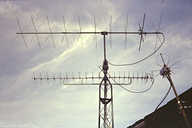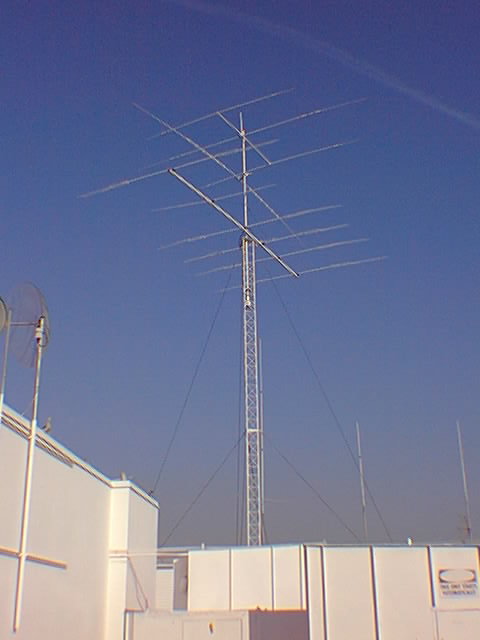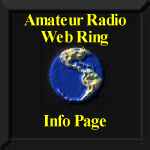Mike's Ham Radio Page


Or, click her to go to the list of HAM terms...
 vhf and uhf beams
vhf and uhf beams
 HF beams
HF beams
Some problems with tube radios that you may encounter are "soft tubes", which
means the final tubes which supply your rf power are getting burned out or are loosing
their original power strength. You may notice that when you are tuning up, your
power may only peak at 50 watts or less. This could be a sign of a bad antenna
match, or soft tubes. Tubes are readily available from many companies for a very
reasonable price.
My current HF rig is the Kenwood TS-440S/AT. This is a solid state radio, which
means it has not tubes and is all microchips and processors. The 440 has the built in
automatic antenna tuner which with the push of a button will tune any antenna in
about 6 seconds. I really enjoy this radio because of the digital display and it's small
size. The 440 that I got was sold to me for a very good price at $670. Solid state rigs
range any where from as low as $400-$6,885. That is a huger range! The rigs that
are around $400 have the basic features and will work well as a mobile or base. The
more expensive rigs have Digital Signal Processing, auto antenna tuners, filters galore
and some even have built in oscilloscopes! However, don't let the expensive rigs get
you down. Most hams cannot afford those big rigs and sometimes the smaller less
expensive ones work better. Solid state rigs are more sensitive to high swr and
voltage spikes. So you have to remember, the more expensive the rig, the more you
have to be careful with. A static spike from lightning may cause a solid state radio to
blow a circuit and be non usable until repaired, yet it may not harm a tube radio.
Lightning protection is very important for any rig and antenna setup that you have. If
you own or are going to purchase a solid state radio, I would highly recommend an in-
line gas discharge coaxial surge protector from Alpha-Delta or Cushcraft. This will
take any spikes from power lines or lightning in your coax and put it into the ground
via a ground rod. It will protect any surges from entering your shack and ruining your
radio. Tube rigs can get by with the less expensive air gap type arresters because
they are less sensitive than solid state rigs. Grounding your antennas, radio's and
power supplies are essential for a safe and well working ham shack.
Antennas weather it be for VHF or HF play a huge roll in the range of your
communications. A beam or Yagi antenna will direct your signal in the direction your
antenna is pointing. To effectively use a beam antenna, an antenna rotor must be
used to turn your antenna to a North, South, East or West position in the direction you
want to talk to. Other types of antennas are vertical, which generate your signal in a
360 degree pattern. These antennas are the most versatile and easiest to put up and
will work without a rotor. A dipole antenna is a long wire antenna that uses a balun or
transformer to match the antenna to its designed frequency(s). I use a G5-RV dipole
here for 80-10 meters on HF. The antenna is 31 feet above the ground, which is a full
wave length on 10 meters. It works excellent and I can make contacts just about any
where in the world when the conditions are good. A dipole can be put up between
trees, across the roof or just about anywhere that has enough room! You can fold
them back or zig zag them to take up less space, and you can also make what is
called an inverted V which will perform very well on the bands. Which ever antenna
you decide to buy, make sure you will have the room and if it is a large beam for HF,
you need a tower because of the wind drag that the large elements will have. Just
remember, most any antenna will work well, choose which is right for you!
Well, that about sums up a portion of what Amateur Radio has to offer. Don't be
afraid to ask other hams on the radio or in person about any question you may have.
Just about any ham will be more than happy to answer any questions that you may
have or help you get an antenna up or even installing a tower! Do not let Morse Code
get the best of you. It will take time and the rewards for the HF bands are well worth
the practice! Remember, ham radio operators are there for one another and the
community, don't be afraid to get involved! Amateur Radio is communicating, don't
forget that! If I can help you any more in any way, please feel free to e-mail me and I
will get back to you a.s.a.p! 73 from KB0YZR
Sign My Guestbook
View My Guestbook
![]()


This Amateur Radio Webring site is owned by mike's ham radio page. Want to join the Amateur Radio Webring? |
|---|
| [Skip Prev] [Prev] [Next] [Skip Next] [Random] [Next 5] [List Sites] |